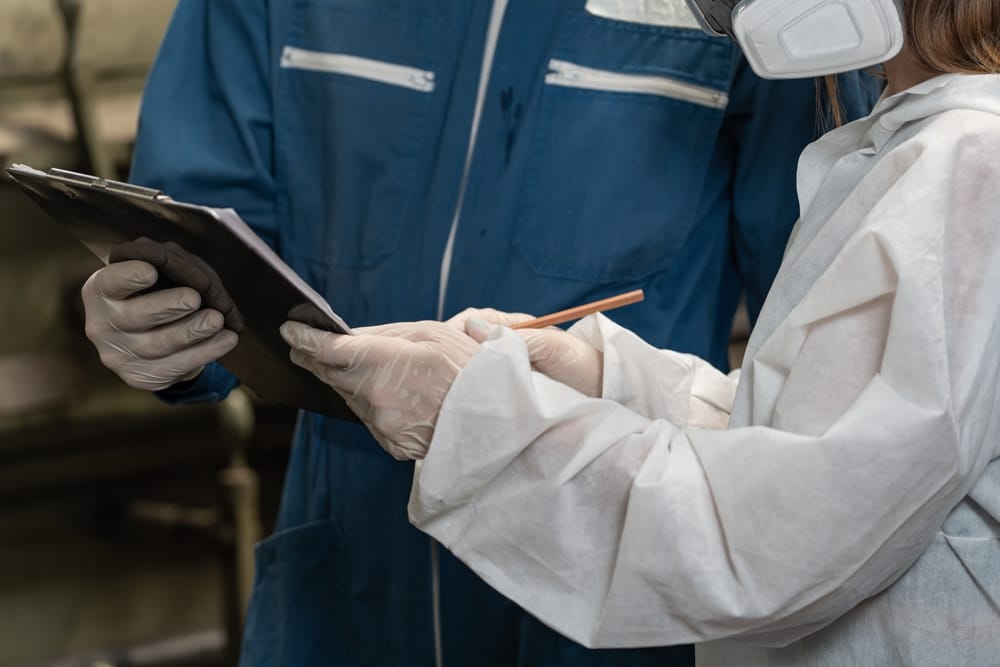Duct cleaning safety, hazards and precautions to look for
Revised by Jason Maxwell, CEO & Director of Operations
- Updated this week

As a professional duct cleaner, your safety is the most important thing. Cleaning ducts can be dangerous since you can find hazardous debris like asbestos and mold.
This article will guide you through the essential safety gear and precautions a duct cleaner needs to take to ensure a safe job site.
By adhering to safety standards and wearing appropriate gear, you can prevent accidents and health issues, ensuring that you return home safely after a job well done.
PPE in Duct Cleaning, Importance and Usage
What is PPE?
PPE means “personal protective equipment”. PPE is often used to talk about protective gear and safety equipment. It’s an equipment that cleaners will use to protect themselves.
PPE includes:
- Safety goggles,
- Respirators,
- Masks,
- Cut-proof gloves,
- Back harnesses,
- Knee pads,
- Bump caps,
- Earplugs.
PPE and Duct Cleaners, why is it important?
It’s crucial because it reduces the likelihood of harm or injury in dusty, dirty, and dangerous work environments.
The use of PPE is not only a best practice but also a regulatory requirement in many jurisdictions. By using PPE, duct cleaners can shield themselves from the myriad of risks present in their work environment, including exposure to biological contaminants, sharp objects, and excessive noise.
Types of PPE and Safety Gear Used in Duct Cleaning
Each type of PPE serves a specific purpose.
- Safety goggles: It offers consistent visibility, allowing cleaners to see what they are doing.
- Respirators and N95 masks: It provides safe and reliable protection from microbes and dust debris.
- Cut-proof gloves: It protects hands from sharp edges, while back harnesses prevent injury or strain during heavy lifting.
- Knee pads: protect against debris or protuberances, and bump caps and earplugs protect against small impacts and hazardous noise levels.
Selecting the right PPE is a critical decision that should be based on a thorough risk assessment of the job site.
Duct cleaners must be trained in the proper use and maintenance of PPE to ensure maximum protection and compliance with safety regulations.
Safety Goggles: Features and Benefits
Safety goggles offer consistent visibility, allowing cleaners to see what they are doing.
They also protect the eyes from dust and debris, which can cause serious eye injuries. The benefits of wearing safety goggles extend beyond injury prevention; they also help maintain the cleaner’s focus and efficiency on the job.
High-quality goggles are designed to resist fogging and provide a comfortable fit, which is essential for long hours of work.
Respirators and N95 Masks: Ensuring Respiratory Safety
They provide safe and reliable protection from microbes and dust debris, which can cause serious respiratory problems.
The selection of the appropriate respirator is based on the specific hazards present and the level of exposure anticipated.
For instance, N95 masks are effective against particulate matter, but in environments with chemical vapors or gases, a different type of respirator may be required. Think about fit testing and training on the use of respirators are essential to ensure that they offer the intended level of protection.
Cut-proof Gloves: Material and Cut Grade Requirements
Cut-proof gloves are necessary to protect hands from sharp edges.
They should be made from Kevlar or high-performance polyethylene and have a cut grade of five or higher.
The material used in these gloves is designed to withstand cuts and abrasions, providing a safeguard against common injuries in duct cleaning. The gloves should offer dexterity and comfort, allowing workers to perform their tasks without hindrance. Regular inspection and replacement of gloves are crucial.
Back Harnesses: Types and Proper Fit
Back harnesses are used for heavy lifting to prevent injury or strain.
They should be the right size and fit for the employees using them. A properly fitted back harness distributes the weight of the load across the body, reducing the risk of back injuries.
Knee Pads: Importance and Selection Tips
Knee pads are essential for duct cleaners who crawl on hands and knees or encounter debris. Knee pads protect the knees from injury and make the job more comfortable.
When selecting knee pads, it is important to look for features such as sturdy construction, adjustable straps, and sufficient padding. Comfort is also a key factor, as knee pads that are too tight or loose can hinder movement and reduce their protective capability.
Bump Caps and Earplugs: When and Why to Use Them
Bump caps are padded head coverings that protect against small impacts in commercial duct cleaning jobs. They reduce the number of head nicks and bumps suffered by cleaners in tight spaces or around large networks of ducts.
Earplugs are recommended for duct cleaners exposed to hazardous levels of noise, such as in mechanical rooms or construction sites.
The use of bump caps and earplugs is a proactive approach to preventing head injuries and hearing loss, which are common occupational hazards.
Dirty Air Ducts, Health Hazards and Safety concerns
What are The Health Risks Associated with Dirty Air Ducts?
Dirty air ducts can cause several health problems, including:
- Asthma,
- Allergies,
- Migraines,
- Release of hazardous particles.
The accumulation of dust, pollen, and other contaminants in air ducts can create an environment conducive to the growth of mold and bacteria.
These contaminants can become airborne and pose health risks to occupants. Then, regular and professional duct cleaning is essential to maintain a healthy indoor air environment.
How Can Duct Cleaners Help Ensuring Safety in Air Quality?
They have the knowledge and experience to clean ducts effectively and safely. They also use proper equipment and follow safety precautions to prevent injury and damage to the HVAC system.
Professional duct cleaners are trained to identify potential hazards and implement control measures to mitigate risks. They understand the importance of maintaining a clean and functional HVAC system.
Safety During Duct Cleaning, Risks and Problems
Physical Hazards: Sharp Edges and Heavy Lifting
These can cause serious injuries if proper safety precautions are not taken. Ductwork often contains metal components with sharp edges that can easily cut or puncture skin. Additionally, the equipment used in duct cleaning can be heavy and cumbersome, posing a risk for musculoskeletal injuries. To mitigate these risks, duct cleaners should be equipped with cut-resistant gloves and use mechanical aids or team lifting techniques for heavy objects.
Environmental Hazards: Dust and Microbial Exposure
They can cause serious health problems if proper safety precautions are not taken. Duct cleaning can disturb large amounts of dust and other particulates that, if inhaled, can lead to respiratory issues.
Microbial contaminants such as mold spores and bacteria can also be present, posing additional health risks. To protect against these hazards, duct cleaners should wear appropriate respiratory protection and ensure that the work area is well-ventilated.
Get a Quick Quote!
Featured Articles

Simple, facile et efficace!
Nous serions ravis de travailler avec vous!
Ontario - Siège social
Ottawa
Téléphone : 613-612-4828
Courriel : service@1cleanair.ca
343, rue Preston, Ottawa, ON K1S 1N4
Québec - Siège social
Gatineau
Téléphone : 819-664-2444
Courriel : service@1cleanair.ca
95, boul. de la Technologie, Gatineau, QC J8Z 3G4
Warning: Attempt to read property "post_type" on null in /home/onecleanair/public_html/wp-content/plugins/prosomo-franchise/includes/pf_name.php on line 28
